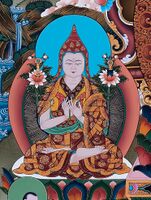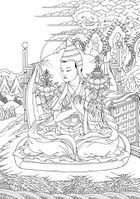| PersonType | Category:Classical Tibetan Authors |
|---|---|
| MainNamePhon | Butön Rinchen Drup |
| MainNameTib | བུ་སྟོན་རིན་ཆེན་གྲུབ་ |
| MainNameWylie | bu ston rin chen grub |
| SortName | Butön Rinchen Drup |
| AltNamesWylie | bu ston kha che · bu ston thams cad mkhyen pa |
| AltNamesOther | Buton Khache · Butön Tamche Khyenpa · Rinchen Drub |
| YearBirth | 1290 |
| YearDeath | 1364 |
| BornIn | khro phu (gtsang) |
| TibDateGender | Male |
| TibDateElement | Iron |
| TibDateAnimal | Tiger |
| TibDateRabjung | 5 |
| ReligiousAffiliation | Sakya |
| ClassicalProfAff | Zhalu Monastery (zhwa lu) |
| ClassicalOtherProfAff | Ripuk Hermitage (ri phug) |
| StudentOf | Kazhipa Drakpa Zhönu |
| TeacherOf | sgra tshad pa rin chen rnam rgyal · phyogs las rnam rgyal · bcu gnyis gsar ma grags pa shes rab · gangs dkar bla ma rin chen bzang po · 'jam dbyangs grags pa rgyal mtshan · g.yung ston rdo rje dpal bzang po · g.yag sde paN chen · Jangchup Tsemo |
| BDRC | https://www.tbrc.org/#!rid=P155 |
| Treasury of Lives | http://treasuryoflives.org/biographies/view/Buton-Rinchen-Drub/2845 |
| IsInGyatsa | No |
| PosBuNayDefProv | Provisional |
| PosBuNayDefProvNotes |
|
| PosAllBuddha | Qualified No |
| PosAllBuddhaNote | Only Buddhas |
| PosAllBuddhaMoreNotes |
|
| PosYogaMadhya | Yogācāra |
| PosYogaMadhyaNotes | In line with his assertion that these teachings are merely provisional he claims, "The general basis of intention of the teachings on buddha nature is the ālaya-consciousness, which refers to the sheer cause of buddhahood." Karl Brunnhölzl, When the Clouds Part, p. 868. |
| PosZhenRang | Rangtong |
| PosZhenRangNotes | Though he didn't explicitly equate his position with Rangtong, he was certainly a vocal opponent of Dölpopa and his Zhentong view. |
| PosAnalyticMedit | Analytic Tradition |
| PosAnalyticMeditNotes | Though he differed from Ngok on certain issues, he was more in line with his approach than that of Tsen Khawoche. |
| PosEmptyLumin | Tathāgatagarbha as the Resultant State of Buddhahood |
| PosEmptyLuminNotes | Specifically, he sees buddha-nature as referring only to the dharmakāya of a fully enlightened buddha.
|
| Other wikis |
If the page does not yet exist on the remote wiki, you can paste the tag |


